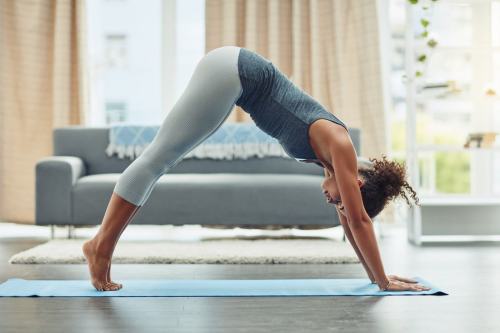The calf-stretching guide that’s way better than a leg massage
Lots of fitness devotees walk around with tight calves, which is not only uncomfortable but not good for your muscles. Here's how to stretch your calves, according to the pros.

Lately, I’ve noticed that I’ve been falling up the stairs on a regular basis. Sure, I’m a little clumsy—but not usually to that level. Then, I realized it was all because I have overly tight calves. You surely know the feeling—like the area of your legs between your ankles and knees is pulled taut like a violin string, and every little movement in your lower body makes you wince.
Calf soreness is very common, but it can also be behind issues that seem totally unrelated elsewhere, such as shin splints and messed-up rotation of the feet and ankles. Here’s the honest truth: Those basic calf-stretching moves (looking at you, toes up the wall) aren’t fully resolving the tightness in the bottom of your legs. To dig deeper, I found out what can make calf tightness a thing of the past. For that, keep on scrolling.
The low-down on your calves
First of all, a mini biology lesson: The gastrocnemius is the big muscle in your calf that gets all of the attention, and its lesser-known partner is the soleus. Cameron Apt, the director of athletic performance services at the University of Rochester Medical Center explains that while both start around your ankle, the gastrocnemius comes up and crosses the back of your knee attaching to your thigh. The soleus, on the other hand (er, leg), runs underneath the gastrocnemius and stops right below your knee.
“When the knee is bent, the soleus is more of the primary mover, and when the knee is straight the gastrocnemius is,” says Apt. So running and field sports work the soleus more because you’re jumping with a bent knee, while moves where you’re jumping with a straight knee—jumping rope or doing a basketball layup—work the gastrocnemius.
How to fully stretch those muscles
To get a really good stretch, Kimberly Caspare, a physical therapist at PHLEX NYC recommends stretching both with your knee bent and straight. Whether you’re in a lunging calf stretch or downward dog, just bending your knees while keeping your weight in that leg will shift the stretch from your gastrocnemius down into your soleus. Apt says you should also make sure you’re pressing the heel down and flexing strongly through the foot during a calf stretch. This will engage muscles on the front and sides of the leg, giving you a more stable base to safely lengthen through the back.
It’s also helpful to keep your workout moves balanced overall to work the opposing muscles. If you do a lot of HIIT-training, which requires you to jump for example, Apt says you should also work the soleus. “If you just do gastrocnemius exercises all the time, it’s going to try to take over a lot of the shared responsibilities the two muscles have together,” he says.
Caspare, who is also a strength and conditioning coach, says you can target the soleus by lifting and lowering your front heel while in a lunge position or by doing calf raises while in a squat. And if you’re in a gym, Apt says to look out for a seated calf raise machine or to try box jumps, which work the two calf muscles together.
To lengthen out the calf (or have it work eccentrically), Apt says to focus on slowly lowering the heels down, to work the muscle through a full range of motion while also stretching it. He notes that this is more advanced than the traditional calf raise, and can cause a bit more soreness. Caspare recommends doing this on a stair with your heels hanging off the edge. You rise up, like in a normal calf raise, and then you lift one leg while slowly pressing the other heel down past the edge of the stair. Once you incorporate these calf stretches on the reg, you’ll be able to go upstairs without, you know, wincing in pain.
Also important to note: How to avoid over-stretching in yoga and Pilates (yes, it’s a thing). And here’s the truth behind 10 of the biggest stretching myths.
Sign Up for Our Daily Newsletter
Get all the latest in wellness, trends, food, fitness, beauty, and more delivered right to your inbox.
Got it, you've been added to our email list.










